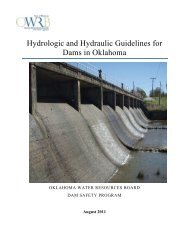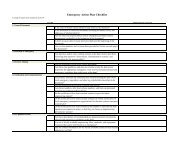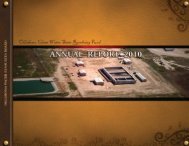Typology and Development of Ancient Water Systems in Israel
Typology and Development of Ancient Water Systems in Israel
Typology and Development of Ancient Water Systems in Israel
- No tags were found...
Create successful ePaper yourself
Turn your PDF publications into a flip-book with our unique Google optimized e-Paper software.
Guid<strong>in</strong>g Pr<strong>in</strong>ciples• <strong>Water</strong> - a source <strong>of</strong> life & people alwaysneed water• <strong>Water</strong> use - private & public <strong>in</strong> ancientsettlements• Availability <strong>of</strong> water <strong>in</strong> antiquity - as largeor larger than today• Challenge - construct water systems &divert the water to the settlements• Pumps not available & transportation <strong>of</strong>water was only by gravitation
Quantities <strong>of</strong> <strong>Water</strong> Per Capita Per Year• Bedou<strong>in</strong>s 1.5 CM = 1 gallon per day• Biblical period 5 CM = 3.5 gallons per day• Byzant<strong>in</strong>e period 7 CM = 5 gallons per day• Jerusalem dur<strong>in</strong>g the 1948 siege - 1.5-2.5gallons per day• 1970 - 70 CM = 50 gallons per day• Today - 120 CM = 82.5 gallons per day
<strong>Typology</strong> <strong>of</strong> <strong>Ancient</strong> <strong>Water</strong> <strong>Systems</strong>1. Wells2. Nearby spr<strong>in</strong>gs (natural)3. Cisterns4. Reservoirs or pools collect<strong>in</strong>g run<strong>of</strong>f5. Reservoirs - beyond the city walls6. Dams7. Natural <strong>in</strong>ner spr<strong>in</strong>gs (w/<strong>in</strong> the city walls)8. Underground - hewn down to the level <strong>of</strong>the water table9. Aqueducts
Which are the most ancient water systems?WellsCisterns
Cisterns Wells‣ Hewn <strong>in</strong> bedrock / stoneconstruction‣ Narrow open<strong>in</strong>g <strong>and</strong> widebody‣ Plastered from top tobottom‣ Large storage capacity‣ “Cannot export morewater than it imports”(Avot de Rabbi Natan =Limited capacity)‣ Dug / hewn to the watertable level‣ Vertical <strong>and</strong> narrow‣ No plaster‣ No need for storagecapacity‣ “<strong>Water</strong> that runs byitself”(Avot de Rabbi Natan =Unlimited quantity <strong>of</strong> water)
Wells• Most ancient wells - Atlit-Yam, dated to 5900 BCE• Deepest well - Tel Beer Sheba, 70 meters deep,dated to 1100 BCE• Wells used throughout history until today• Monumental water systems preferred <strong>in</strong> fortifiedcities• Wells usually public, serv<strong>in</strong>g the entirecommunity
Wells from PPNe to Iron Age 2LegendIron Age 2Iron Age 1Late BronzeAtlitCarmel CoastSea<strong>of</strong>GallileeMiddle BronzeNamiEarly BronzeChalcolithicDorBet SheanP NeolithicPP NeolithicKm.GerisaMediterranean SeaBet ShemeshLachishGemahHarorAbu H<strong>of</strong>Beer ShebaAradH. TovDeadSeaH. BatarUvda
Beer-Sheba WellSouthern <strong>Israel</strong>Deepest Well70 m; 230 Ft.
• Beg<strong>in</strong>n<strong>in</strong>g use - 3000 BCE• First cisterns - small, hewn out <strong>of</strong> chalk, unplastered• First plastered cisterns - Hazor <strong>and</strong> Gezer, dat<strong>in</strong>gto 1800 BCE, bottle-shaped• Plastered cisterns ma<strong>in</strong>ly bell-shaped• Peak <strong>of</strong> cistern-use – Byzant<strong>in</strong>e Period, 500 CE• Used to this day• Usually for private useCisterns
LegendIron Age 2Iron Age 1Late BronzeMiddle BronzeEarly BronzeKm.MezerRosh ZeitTaanachSea<strong>of</strong>GalileeYezraelHazorMediterranean SeaAshdodBanat BarQlaShilohTel DalitMargamaGezerRadanaHaAiNasbehShilhaDir e-SirBet ShemeshQumranEl-KichAbu Twe<strong>in</strong>BuqeiaBet MirsimDeadSeaTel HalifTel IraUzaRadumNegev Highl<strong>and</strong>Um el BayaraCisterns from the Early Bronze to Iron age 2
QumranNeqarot CisternMt. Negev
Reservoirs or Pools Collect<strong>in</strong>g Run<strong>of</strong>f• Reservoirs with a capacity greater than 150 cubicmeters collect<strong>in</strong>g run<strong>of</strong>f by channels (built or dug)• Used <strong>in</strong> fortified cities dur<strong>in</strong>g times <strong>of</strong> peace &siege• First reservoirs (2500 BCE) at Arad & HaAi (Et-Tell)- ma<strong>in</strong>ly open, w/o plaster• Hazor (Northern <strong>Israel</strong>) - a reservoir under thepalace ca. 1300 BCE (LB Period)• Well-known underground reservoirs, urban orroyal (Judean K<strong>in</strong>gdom) - Tel Beer Sheba, Arad,Eitam, Bet Shemesh & Amman
Tel AradCentral Reservoir
<strong>Typology</strong> <strong>of</strong><strong>Water</strong> Shafts & TunnelsABCDEShaft/Tunnel toExteriorSpr<strong>in</strong>gShaft/Tunnel to<strong>Water</strong>Table<strong>Water</strong>Conductedto Bottom<strong>of</strong> Shaft/TunnelFeed<strong>in</strong>gTunnel &ChannelstoReservoirsExteriorApproachto <strong>Water</strong>Source
Tunnels & Shafts to Inner Spr<strong>in</strong>gs(w/<strong>in</strong> city walls)• Used for a short period• Fortified cities - built around a spr<strong>in</strong>g, ca.1800 BCE = MB IIb• Sites - Tel Dan, Kabri, Jericho• Jerusalem - spr<strong>in</strong>g situated w/<strong>in</strong> the citywalls & supplied by a hewn tunnel• Inner spr<strong>in</strong>gs - built by the government
Jerusalem4 Parts:1. Tunnel which was cut to direct waterfrom the plentiful Gihon Spr<strong>in</strong>g2. Stepped tunnel - cut downward fromthe street level beh<strong>in</strong>d the city’sdefense wall3. Almost horizontal tunnel ramp runn<strong>in</strong>gout under the city wall to a po<strong>in</strong>tdirectly above the water chamberlead<strong>in</strong>g to #44. A shaft connected the end <strong>of</strong> thisupper tunnel to the water chamber.
Underground <strong>Water</strong> <strong>Systems</strong>Hewn Down to Level <strong>of</strong> <strong>Water</strong> Table• First appearance - Tel Gezer <strong>and</strong> Tel Gerisa,ca. 3800 BCE• Ma<strong>in</strong>ly 1000 BCE - Megiddo, Hazor, Gibeon,Yebleam, Jokneam <strong>and</strong> Lachish(?)• Hewn <strong>in</strong>side fortified cities - <strong>in</strong> time <strong>of</strong> siege• Built by the government• Disappeared - end <strong>of</strong> the Judean K<strong>in</strong>gdom
Tel Gerisa1800 BCETel Aviv
Megiddo
Megiddo Iron Age II1. Spr<strong>in</strong>g2. Spr<strong>in</strong>g chamber3. Pre-10th cent B.C. stairs to spr<strong>in</strong>gchamber4. 9th cent B.C. block<strong>in</strong>g wall atentrance to chamber5. 9th cent B.C. tunnel6. 9th cent B.C. stepped shaft7. 9th cent B.C. <strong>in</strong>set <strong>of</strong>fset wall8. Solomonic (10th cent B.C.) gallery9. Solomonic (10th cent B.C.) coveredstairway
SteppedTunnel=Grade- 35 ₒL - 127 m,416 ft.
HazorNorthern <strong>Israel</strong>
1.Rock-hewn shaft with steps2.Entrance structure3.Stepped (or slop<strong>in</strong>g) tunnellead<strong>in</strong>g to water table4. 9th cent B.C. 4-room <strong>Israel</strong>itehouse5. 10th cent B.C. Solomoniccasemate wall6.Chamber on water table7.Pool on water table
Stepped Tunnel =Gradient - 29 ₒLength - 80 m, 262 ft.
Gibeon <strong>Water</strong> Shaft &Tunnel
1. Pre-10th cent B.C. “pool”2. Stepped shaft to watertable3. Chamber at water table4. City wall constructed <strong>in</strong>12th–10th centuries B.C.5. Spr<strong>in</strong>g6. Feeder tunnel to <strong>in</strong>creaseflow <strong>of</strong> spr<strong>in</strong>g to waterchamber7. <strong>Water</strong> chamber8. Outside entrance to waterchamber9. Stepped (or slop<strong>in</strong>g) tunnelfrom <strong>in</strong>side city to waterchamber
<strong>Water</strong> Shaft
<strong>Water</strong> ChamberGibeon <strong>Water</strong> TunnelGradient = 43 ₒLength = 48 m,157ft.
GezerMiddle Bronze Age1800 BCE
Macalister’s 1905 Dig
28.80 m. below surfaceEntrance – Keyhole shaped,10.5 m. deep, w/ stepsTunnel – Gradient = 39 ₒ- Length 40m, 140 ft.,- Height -7.5 m,- Width - 4 m.- StepsDraw<strong>in</strong>g by V<strong>in</strong>cent
Gezer Shaft/Tunnel1.Rock-cut shaft2.Stepped (or slop<strong>in</strong>g)tunnel3.Chamber on water table4.Southern Gate <strong>in</strong>Middle Bronze wall5.Middle or Late Bronzewall (<strong>in</strong>itial phase built2000-1500 BCE)
Gezer Tunnel
Architectural Features
Daily Operation
StepsEntrance to Cavern
Goals for Summer 2012
9. AqueductPPNeNECLEBMBLBIron 1Iron 2Hell.Rom.Byz.Med.6000BCE5000BCE4000BCE2500BCE1800BCE1400BCE1100BCE800BCE200BCE200CE500CE1200CE1 Well2NearbySpr<strong>in</strong>g3Cistern4Reserv.PoolRun<strong>of</strong>f5 Dam6 InnerSpr<strong>in</strong>g7 Unde.<strong>Water</strong>System8 Reser.OuterSource
General Conclusions About <strong>Water</strong> <strong>Systems</strong>:• <strong>Typology</strong> - gives only general picture on the subject <strong>in</strong>each region• Certa<strong>in</strong> developments can be traced throughout history• Wells appeared first, lead<strong>in</strong>g to the development <strong>of</strong>underground, monumental water systems• Cisterns next, lead<strong>in</strong>g to the development <strong>of</strong>underground reservoirs• Research can be used for comparative analysis• Research is just beg<strong>in</strong>n<strong>in</strong>g <strong>and</strong> needs to be cont<strong>in</strong>ued
www.nobts.edu/ArchaeologyCenter/http://nobtsarchaeology.blogspot.com/














![A Commodity & a Resource [pdf] - Water Resources Board - State of ...](https://img.yumpu.com/42536671/1/190x143/a-commodity-a-resource-pdf-water-resources-board-state-of-.jpg?quality=85)

